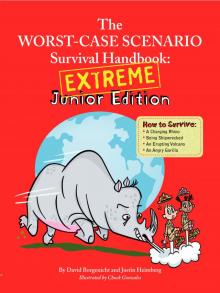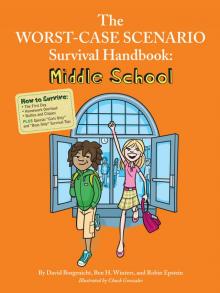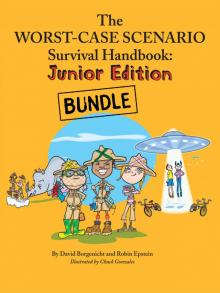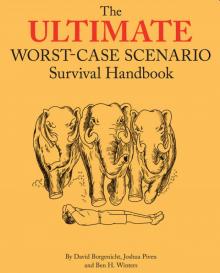- Home
- David Borgenicht
Holidays
Holidays Read online
The
WORST-CASE SCENARIO
Survival Handbook:
Holidays
By Joshua Piven and David Borgenicht
Illustrations by Brenda Brown
WARNING
When a life is imperiled or a dire situation is at hand, safe alternatives may not exist—and elves are not always around to help out. To deal with the holiday worst-case scenarios presented in this book, we highly recommend—insist, actually—that the best course of action is to consult a professionally trained expert. But because highly trained professionals may not always be available when the safety or sanity of individuals is at risk, we have asked experts on various subjects to describe the techniques they might employ in these seasonal emergency situations. The publisher, authors, and experts disclaim any liability from any injury that may result from the use, proper or improper, of the information contained in this book. All the information in this book comes directly from experts, but we do not guarantee that the information contained herein is complete, safe, or accurate, nor should it be considered a substitute for your good judgment, your common sense, or your sense of peace on earth and goodwill toward men. And finally, nothing in this book should be construed or interpreted to infringe on the rights or presents of other persons or to violate criminal statutes; we urge you to obey all laws and respect all rights, including property rights, of others.
—The Authors
Table of Contents
WARNING
INTRODUCTION
CHAPTER 1 COOKING AND ENTERTAINING
HOW TO EXTINGUISH A BURNING TURKEY
HOW TO SERVE BURNT TURKEY
HOW TO PREVENT A TURKEY FROM EXPLODING
HOW TO KEEP A TURKEY MOIST DURING COOKING
HOW TO REMOVE A GRAVY STAIN
HOW TO PUT OUT A GREASE FIRE
HOW TO TREAT A GREASE BURN
HOW TO REPURPOSE A FRUITCAKE
HOW TO SAFELY EAT A FRUITCAKE
HOW TO OPEN A BOTTLE OF WINE WITH A BROKEN CORK
WITH A VERY DRY CORK
HOW TO OPEN A BOTTLE OF WINE WITHOUT A CORKSCREW
HOW TO AVOID SHOOTING A CHAMPAGNE CORK
CHAPTER 2 FRIENDS AND FAMILY
HOW TO DEAL WITH A MEDDLING PARENT
HOW TO SURVIVE IF YOU HAVE NO ONE TO KISS ON NEW YEAR’S EVE
IF YOU ARE WITH OTHERS
IF YOU ARE ALONE
HOW TO FEND OFF AN UNWANTED KISS
ON ARRIVAL
UNDER THE MISTLETOE
HOW TO OVERCOME HOLIDAY DEPRESSION
HOW TO DEAL WITH POST-HOLIDAY DEPRESSION
CHAPTER 3 HOLIDAY EMERGENCIES
HOW TO TREAT FOOD POISONING
HOLIDAY FOOD ALERT
HOW TO EXTINGUISH A CHRISTMAS TREE FIRE
HOW TO PREVENT A CHRISTMAS TREE FIRE
HOW TO SURVIVE A FALL FROM A LADDER
HOW TO SURVIVE CHRISTMAS TREE LIGHT DISASTERS
HOW TO UNTANGLE CHRISTMAS TREE LIGHTS
HOW TO RESPOND TO PROLONGED TREE-LIGHT SHOCK
HOW TO RESIZE A CHRISTMAS TREE
IF IT IS TOO TALL FOR THE ROOM
IF IT IS TOO WIDE FOR THE STAND
HOW TO PREVENT A TREE FROM TOPPLING OVER
HOW TO MAKE AN UNTIPPABLE TREE STAND
HOW TO MAKE A CEILING GUY WIRE
HOW TO MAKE WALL GUY WIRES
HOW TO TREAT MISTLETOE POISONING
IN PETS
IN PEOPLE
HOW TO MAKE AN EMERGENCY MENORAH
BAKED MENORAH
BOWL AND DIRT MENORAH
HOW TO MAKE MENORAH CANDLES FROM CRAYONS
HOW TO MAKE AN EMERGENCY ANGEL
PAPER PLATE ANGEL
ALUMINUM FOIL ANGEL
ALTERNATIVE ORNAMENTS
HOW TO FIT INTO CLOTHING THAT IS TOO TIGHT
FOR MEN
FOR WOMEN
HOW TO SILENCE A GROUP OF CAROLERS
HOW TO SING ALONG WHEN YOU DON’T KNOW THE WORDS
CHAPTER 4 SHOPPING SURVIVAL
HOW TO EVADE A STAMPEDE OF SHOPPERS
HOW TO PENETRATE A CROWD TO GET THE LAST ITEM ON THE SHELF
HOW TO DEAL WITH A BAD GIFT
HOW TO THWART GIFT SNOOPERS
HOW TO DETERMINE THE CONTENTS OF A WRAPPED GIFT
WITHOUT OPENING THE PRESENT
HOW TO REWRAP A GIFT
HOW TO WRAP A PRESENT WITHOUT WRAPPING PAPER
HOW TO WRAP A PRESENT WITHOUT TAPE
HOW TO TREAT A WRAPPING-PAPER CUT
CHAPTER 5 SURVIVING THE GREAT OUTDOORS
HOW TO ESCAPE A RUNAWAY PARADE BALLOON
HOW TO DEAL WITH A CANCELED FLIGHT
HOW TO DRIVE IN A BLIZZARD
IF YOU SKID
IF YOU GET STUCK IN THE SNOW
IF YOU BECOME STRANDED
HOW TO STOP A RUNAWAY ONE-HORSE OPEN SLEIGH
HOW TO JUMP FROM A RUNAWAY SLEIGH
HOW TO FEND OFF A CHARGING REINDEER
HOW TO RESCUE SOMEONE STUCK IN A CHIMNEY
HOW TO CLIMB DOWN A CHIMNEY
HOW TO SURVIVE A RUNAWAY SLED
HOW TO WIN A SNOWBALL FIGHT
HOW TO MAKE SNOWBALLS
HOW TO BUILD A SNOW FORT
HOW TO TREAT A TONGUE STUCK TO A POLE
APPENDIX
THE “THERE IS NO SANTA CLAUS” SPEECH
NEW YEAR’S RESOLUTION-O-MATIC
THE EXPERTS
ABOUT THE AUTHORS
ACKNOWLEDGMENTS
More Worst-Case Scenarios
You better watch out…
—”Santa Claus Is Coming to Town”
INTRODUCTION
The world thinks of the Holidays as a time of peace and joy—a time when all is harmonious, and we all join together eating, drinking, and generally being merry. We give gifts, we donate to charities, we spend time with our friends and loved ones—what could possibly go wrong?
Consider this: More suicides, car accidents, family arguments, and food and alcohol poisonings take place during the months of November and December than any other time of the year. Add travel mishaps, kitchen disasters, snow- and ice-related injuries, electrocutions, tree-trimming catastrophes, and gift-related traumas—there’s no such thing as a silent night when it comes to the holidays.
You may not be able to control Mother Nature, acts of God, mischievous elves, or bad cooks. But you can plan ahead to make sure that you’re ready to act when your holiday plans take an unscheduled dive.
We sincerely hope that the worst that awaits you this holiday season is merely a minor mishap—a slightly overcooked turkey, a precariously balanced Christmas tree, or an unwanted gift. But in case tidings somewhat less comforting and joyful come your way, we want you to be prepared.
And so, as we did with our other Worst-Case Scenario Survival Handbooks, we’ve consulted dozens of highly trained professionals to come up with clear, step-by-step instructions for how to survive the perils of cooking and entertaining, friends and family, shopping, and assorted emergencies indoors and in the great outdoors. We spoke with chimney sweeps, physics professors, wilderness survival instructors, travel journalists, neurologists, craftmakers, professional carolers, gift consultants, motivational speakers, veterinarians, dentists, etiquette instructors, and dozens of others to obtain the responses to the worst worst-case scenarios we could imagine.
From how to extinguish a grease fire to how to fend off a charging reindeer, from how to deal with a run-away parade balloon to how to safely fall from a ladder, and from how to repurpose a fruitcake to how to make an emergency menorah, this handy guide should keep you safe and sound—at least between the end of November and New Year’s Day. In a useful appendix, we’ve also included a New Year’s Resolution-O-Matic and a sample “There
is no Santa Claus” speech.
Being prepared is the best present you can give others—or yourself. (This book will fit in every stocking and under every tree.) With this guide in hand, you will be all set. So relax and enjoy the holidays. We hope that all your wishes come true and that your scenarios are best-case scenarios. But don’t count on it.
—The Authors
CHAPTER 1
COOKING AND
ENTERTAINING
HOW TO EXTINGUISH A BURNING TURKEY
1. Close the oven and broiler doors.
Turn the oven off.
2. Open nearby windows.
Smoke will pour out of the oven vent. Turn the vent-fan in the hood above the stove to its highest setting and open windows to help clear smoke. If possible, close the doors to the kitchen to contain the smoke. If you cannot close off the kitchen, open as many other windows in the building as possible to establish cross-ventilation.
3. Wait five minutes.
Ovens are designed for high heat, so it should contain the fire without a problem. Keep the oven door closed to avoid adding oxygen to the fire.
4. Open the oven door slightly.
Keep your face well back from the oven when you open the door. After five minutes, the turkey fire should have burned itself out. If it is still burning, close the door immediately and wait several minutes before opening it again. If the fire continues to burn for more than 10 minutes, call the fire department.
5. Remove the burned bird.
Use caution: It will be extremely hot. Place the bird on a cutting board or platter. Wait at least 10 minutes before touching the turkey or attempting to rescue the meat. Often only the skin and fat will be burned. (See “How to Serve Burnt Turkey”).
Be Aware
Oven fires can usually be extinguished without help from the fire department. However, oven seals may fail in a high-heat fire, causing the fire to spread to surrounding areas. Have someone standing by the phone to call for help if needed.
Do not attempt to pull a flaming turkey out of the oven: You risk grease burns on your arms and face.
Do not attempt to smother a flaming turkey while it is in the oven. The high temperatures and flaming grease may ignite the material.
Do not attempt to douse the fire by throwing flour, baking soda, gravy, or any other products on a flaming turkey. These may be combustible and may cause grease to spatter. Using a fire extinguisher will render the bird inedible.
HOW TO SERVE BURNT TURKEY
1. Remove the skin and charred sections.
Discard these burned parts.
2. Slice the turkey.
3. Pick out the scorched pieces.
Usually the burned portion will be white (breast) meat, which has less fat. Discard it.
4. Check the dark meat.
Some dark meat may also be severely overcooked. Pick out the moist sections and put them on a platter that has been warmed in the oven. Cover and set aside.
5. Moisten dry dark meat.
Layer the salvaged but dry dark meat in a roasting pan. Soak it with several cups of chicken broth and melted butter. Cover it with a cloth and put it in a warm oven (make sure the oven is turned off). Let the meat rest for a few minutes. Drain and remove meat from pan and place on serving tray. Do not use a microwave to warm the meat or the meat will toughen.
6. Fatten the gravy.
Add one stick of butter to a boiling pot of gravy, let the butter melt, and allow the gravy to cool to serving temperature. Pour the mixture over the turkey after it has been carved.
7. Make turkey hash.
If all else fails, chop the meat, toss with potatoes and bacon, and offer your guests turkey hash. Tell them it’s an old family tradition. Serve with large glasses of water.
HOW TO PREVENT A TURKEY FROM EXPLODING
1. Use a maximum of four beaten eggs in the stuffing.
Eggs expand as they cook and can force stuffing to explode out of the turkey’s abdomen.
2. Stuff the bird loosely.
Leave several inches of space for the stuffing to expand as it roasts.
3. Keep a close watch on the bird as it cooks.
Check the turkey every 20 minutes or so. If the stuffing begins to leak out of the abdominal cavity, remove several spoonfuls.
Be Aware
Cooking the stuffing separately avoids potential bacterial contamination of the stuffing from the turkey and will also avoid any possibility of explosion.
HOW TO KEEP A TURKEY MOIST DURING COOKING
Soak the bird overnight in brine.
To make brine, dissolve one pound of salt per gallon of water; it should be as salty as seawater. Put the mixture in a large bucket (use plastic to avoid any metallic taste). Cover and leave the bird outside to keep it cool. If the temperature is above 50° F or well below 32° F, keep it refrigerated instead.
Remove the legs of the turkey before cooking it.
Dark meat takes longer to cook than white meat, so cook the legs separately from the body. If you want to leave them on, cut the skin between the breast and the legs and spread them out, away from the abdomen, to expose more of the leg to heat.
Cook the turkey breast-side down.
Cooking breast-side down will cause the juices to run down the sides and baste the breasts. Flip it over just before removing from the oven to crisp the skin.
HOW TO REMOVE A GRAVY STAIN
Try the following techniques until one succeeds in removing the stain.
1. Remove excess food as soon as possible.
Use a spoon or a blunt knife to scrape the stain. The longer a stain sets, the more difficult it is to remove.
2. Make a detergent solution.
Mix one teaspoon of clear, mild liquid dishwashing detergent with one cup of lukewarm water. Do not use detergent that contains bleach.
3. Apply the detergent solution to the stain.
Do not rub the stain. Work from the edge of the stain in, gently blotting.
4. Rinse the stain with cold water and blot dry.
If the stain comes out, go to step 14.
5. Make an ammonia solution.
If the detergent solution does not work, mix one tablespoon of household ammonia with ½ cup of warm water.
6. Apply the ammonia solution to the stain.
Blot the stain. Do not rub.
7. Rinse with cold water and blot dry.
If the stain now comes out, go to step 14.
8. Make a vinegar solution.
Mix 1/3 cup white vinegar with 2/3 cup cold water.
9. Blot the stain with the vinegar solution.
10. Rinse with cold water and blot dry.
If the stain has disappeared, go to step 14.
11. Apply commercial enzyme detergent.
Enzyme detergent is available in grocery, drug, and hardware stores. Blot the stain.
12. Rinse the area with cold water.
13. Blot dry.
Place a ½-inch-thick pad of white paper towels over the stained area and weigh it down with a flat, heavy object—a thick book works well. Change the absorbent pad until the transfer of the stain is no longer visible on the pad.
14. Launder according to manufacturer’s label.
HOW TO PUT OUT A GREASE FIRE
1. Do not douse with water.
Oil and water do not mix: Water will cause the burning oil to spatter and spread the fire. Do not move the burning pan to the sink.
2. Turn off the stove.
3. Put on an oven mitt.
Large mitts are the safest option. If barbecue mitts—those that cover the forearm—are available, use for added protection.
4. Find a lid that fits the pan.
A lid that is slightly larger than the pan will also work.
5. Hold the lid at an angle toward the fire.
Do not try to lower the lid directly onto the pan or you risk burning your arms. Keep your face and chest as far from the flames as possible.
6. Slide the lid onto t
he pan and hold it in place until the pan cools.
The pressure from the heat and flame can force a lid off the pan. Hold it securely in place.
7. Do not lift the lid.
Lifting the lid will add oxygen and feed the fire. Take the lid off only when the pan has become noticeably cooler.
8. If no lid is available, use baking soda.
Dump a large amount of baking soda on the grease fire to extinguish it quickly. Avoid using baking powder, which can cause the fire to flare.
Be Aware
Do not use a dry chemical extinguisher to try to put out a grease fire. It is not effective, and the force of the compressed chemical agent can splatter burning material and spread flames.
Never leave cooking oil to heat unattended: Flames may develop quickly.
HOW TO TREAT A GREASE BURN
1. Cool the burned area.
Immediately run cold water over the burned area for several minutes or until the injury site is cool.

 Extreme Junior Edition
Extreme Junior Edition Middle School
Middle School The Worst-Case Scenario Survival Handbook: Middle School
The Worst-Case Scenario Survival Handbook: Middle School Junior Edition Bundle
Junior Edition Bundle The Worst-Case Scenario Ultimate Adventure Novel: Deadly Seas
The Worst-Case Scenario Ultimate Adventure Novel: Deadly Seas Holidays
Holidays Ultimate Adventure Novel: Mars
Ultimate Adventure Novel: Mars Ultimate Worst-Case Scenario Survival Handbook
Ultimate Worst-Case Scenario Survival Handbook